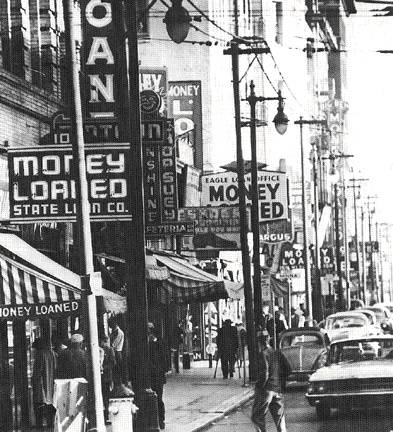TOOR (Tenants and Owners in Opposition to Redevelopment): Difference between revisions
m (1 revision(s)) |
m (categories and links) |
||
| Line 23: | Line 23: | ||
''--Ben Ratliff'' | ''--Ben Ratliff'' | ||
''photo courtesy San Francisco History Room, San Francisco Public Library'' | |||
[[Firemen Doused with Whiskey HISTORIC BUILDING SAVED |Prev. Document]] [[Soma1$soma-redevelopment$old-men itm.html |Next Document]] | |||
[[category:Neighb:SOMA]] [[category:1960-1970]] [[category:redevelopment]] | |||
[[ | |||
Revision as of 22:18, 30 March 2008
3rd & Mission, 1961
In 1967, executive director Justin Herman and his San Francisco Redevelopment Agency began the official displacement of SOMA residents to facilitate the building of the Yerba Buena Center. By mid-1969, the Redevelopment agency had acquired 44% of the land in the project area. The agency was putting pressure on the remaining landowners in the area to sell their property. Those hotels that the agency had taken control of quickly fell into disrepair, and the neighborhood rapidly became a slum.
At the time, the South of Market area was a community of poor and elderly people, who were attracted to the low-rent housing and relatively safe neighborhood streets. Many of the residents had lived there for years, averaging less than $40 a month rent.
The San Francisco Redevelopment Agency had been eyeing the neighborhood for some time as a natural place to accommodate the overflow of businesses from the financial district. Having already completed the Western Addition project, the SFRA sought to build a huge convention center in SOMA that would generate big money for San Francisco hotels and businesses. Both the Chronicle and Examiner had tracts of land near the proposed site for the Yerba Buena center, and, not surprisingly, applauded the SFRA in numerous editorials.
In 1968, the San Francisco Neighborhood Legal Assistance Foundation filed a petition with the local branch of Housing and Urban Development asking for the SFRA's relocation plan. Although the Legal Assistance Foundation filed its petition repeatedly, HUD claimed there was no process for a hearing. They also falsely claimed that relocation had not actually begun.
Finally, in 1969, local residents became fed up with the intransigence of HUD and formed their own organization, known as the Tenant and Owners in Opposition to Redevelopment (TOOR). Founded in the lobby of the Milner Hotel, the slogan of the organization was "We Won't Move," although its ultimate objective was merely to find decent new housing for displaced residents of the area. TOOR was fronted by George Woolf, a former leader of the Alaska Cannery Worker's Union, and Peter Mendelsohn, a sailor who had returned from his final voyage to find the SFRA had taken control of his property.
In spite of a study conducted by HUD revealing that former residents were not likely to find appropriate housing anywhere else in the city, neither HUD nor the SFRA responded to pleas for a coherent relocation plan. On November 5, 1969, TOOR brought suit against the SFRA, charging that it had not found alternative housing, as promised. An independent study commissioned by TOOR showed that there were only 200 vacancies citywide that were considered affordable by area residents. The report also chronicled crimes against elderly SOMA residents who had already relocated to more dangerous areas like the Tenderloin. SFRA leader Justin Herman called the crime reports "a hoax" deliberately staged by the opposition to whip up popular support.
TOOR and its lawyers eventually got a restraining order halting demolition and relocation until an agreement had been reached by both parties. Despite attempts by the presiding judge to urge the parties to negotiate, SFRA repeatedly refused to obey the spirit of the order by harassing residents in the area, urging them to move voluntarily. Finally, on April 30, 1970, Federal District Court Judge Wiegel ordered an injunction against the SFRA, ordering that federal funds for the project be cut off if the organization did not come up with an acceptable plan of relocation. This was a unique instance in American urban history -- federal court judges do not often question the policies of HUD.
To break the deadlock, both parties agreed to bring in former California governor Edmund "Pat" Brown as a "special master" to evaluate the situation and make recommendations to the court about what actions should be taken. Members of the SFRA were chummy with the veteran politico and figured he would give the green light to the redevelopment plan. Instead, Brown recommended that 2,000 new units of low-rent housing be built for the former residents of the area, and that no relocation occur until the units were completed. Caught off guard, the SFRA repudiated Brown's findings and demanded the injunction be lifted, using the argument that HUD had already approved of their plan.
The wrangling of TOOR and the SFRA eventually ended in a decree by Judge Weigel that 1500-1800 new units of housing be built for displaced residents, who would retain control over four of the project area hotels as "hostages" until the building was complete. Justin Herman signed the decree, marking a victory for TOOR in a case that had no precedent. But the SFRA managed to get around the stipulations of the agreement by convincing the San Francisco Housing Authority to give "super priority" to residents in the YBC area on the long list for publicly-funded housing. Of course, this meant that many who had waited for public housing for years, including those that had been displaced by the Western Addition project, were bumped down the list. In the end, only a handful of SOMA residents were properly relocated as per the agreement.
--Ben Ratliff
photo courtesy San Francisco History Room, San Francisco Public Library

